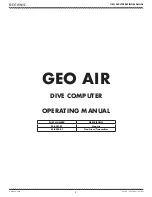
Theory of Operation
6
VSWR Alarm
The ACMI continuously monitors forward and reflected power. From the power
measurements, the VSWR is calculated and compared to the allowed maximum
(default of 1.5 to 1). Based on the results of the comparison, possible actions
include:
No alarm is activated if the VSWR is less than the maximum, or if the
VSWR alarm is disabled.
If the VSWR is equal to or slightly greater than the maximum,
additional measurements are accumulated for up to 30 seconds to
determine a trend before triggering the alarm. If the VSWR trend is
greater than the maximum level, an alarm is triggered, otherwise,
measurements continue until a trend is established. An alarm will be
triggered if the VSWR exceeds the maximum for more than thirty
seconds.
If the VSWR is much greater than the maximum then an alarm
condition is triggered immediately.
Alarm on Zero Power
When the forward power is very small (< 2.5% of full scale), the measured VSWR
becomes large due to the noise floor of the sensor. Under these conditions, the
VSWR level is meaningless. When the zero power alarm is disabled, the VSWR
will not be monitored at these low powers.
High Power Alarm
When the high power alarm is enabled, the forward power is continuously
monitored. The alarm trigger is a percentage of the Monitor’s full scale power,
from 0 – 125%. If the forward power is greater than the trigger level, an alarm is
triggered.
Low Power Alarm
When the low power alarm is enabled, the forward power is continuously
monitored. The alarm trigger is a percentage of the Monitor’s full scale power,
from 0 – 125%. If the forward power is less than the trigger level, an alarm is
triggered.
















































